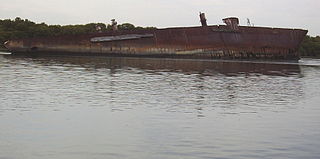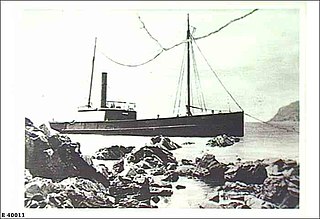
Hereward, was British clipper ship that was built in Scotland in 1877. She had an iron hull, three masts and full rig.

Queen of Nations was a wooden-hulled, three-masted clipper that was built in Scotland in 1861 and wrecked on the coast of New South Wales in 1881. She spent her entire two-decade career with George Thompson, Junior's Aberdeen White Star Line.

Loch Vennachar was an iron-hulled, three-masted clipper ship that was built in Scotland in 1875 and lost with all hands off the coast of South Australia in 1905. She spent her entire career with the Glasgow Shipping Company, trading between Britain and Australia. The company was familiarly called the "Loch Line", as all of its ships were named after Scottish lochs. The ship was named after Loch Venachar, in what was then Perthshire.

Elizabeth Reef, located at 29°57′25″S159°4′32″E, is a coral reef in the Coral Sea. The reef is separated by a deep oceanic pass, some 47 km wide, from nearby Middleton Reef, both of which are part of the underwater plateau known as the Lord Howe Rise. It is around 150 km from Lord Howe Island and 600 km from the New South Wales coast of Australia. The Environment, Sport and Territories Legislation Amendment Act 1997 included Elizabeth Reef in Australia's Coral Sea Islands Territory.

The Santiago was a 455-ton barque launched in 1856. It was built by Henry Balfour of Methil, Fife for the Liverpool shipping company Balfour Williamson. It sailed mainly between Liverpool and Chile, but also to Australia. Its remnant hull, which lies in a ships' graveyard in South Australia, was considered 'the oldest intact iron hull sailing vessel in the world', until part of the central section collapsed in January 2023.

Lady Elizabeth was a British ship built in 1869 by Robert Thompson Jr. of Sunderland. Robert Thompson Jr. was one of the sons of Robert Thompson Sr. who owned and operated the family ran shipyard J. L. Thompson & Sons. Thompson Jr. eventually left the family business in 1854 to start his own shipbuilding business in Southwick, Sunderland. She was 658 tons and was classified as a barque cargo sailing ship with one deck and three masts. She had a keel and outer planking made from American rock elm and a fore end made from English elm. The stem was made of teak and English oak with an iron floor as the deck. The ship also had copper and iron fastings. The ships was also registered in London under the name Wilson & Co. Messrs Wilson & Co. was based out of Sydney, Australia. The ship carried a comparative classification under American Lloyd's as "First class-third grade"

Wardang Island, also known as Waralti is a low-lying 20 km2 island in the Spencer Gulf close to the western coast of the Yorke Peninsula, South Australia. It acts as a natural breakwater, protecting the former grain port of Port Victoria and providing a sheltered anchorage. After European colonisation it was used for the grazing of sheep, for rabbit disease research, was quarried for lime to supply the lead smelter at Port Pirie and is currently leased to the island's traditional owners: the Narungga. The much smaller Goose Island and the other rocks and islets in the Goose Island Conservation Park lie off the northern end. Anyone seeking to visit the island must obtain prior permission from the Point Pearce Community Council.
The Society for Underwater Historical Research (SUHR) was an amateur maritime archaeology organisation operating in South Australia (SA). It was formed in 1974 by recreational scuba divers and other persons to pursue an interest in maritime archaeology and maritime history. The SUHR was renamed as the South Australian Archaeology Society in March 2012 as part of a plan to expand its activities beyond maritime archaeology to include other archaeological disciplines.

Ellen was a steamship that was launched in 1883 and whose career involved coastal shipping firstly in the Colony of Queensland and then in the Australian state of South Australia. It was wrecked in Gulf St Vincent in South Australia at Morgan's Beach near the town of Cape Jervis on Saturday, 12 December 1908 during its return from fishing in waters around Kangaroo Island to a destination on the mainland.
Water Witch was a single-masted vessel rigged as a cutter built during 1835 in Van Diemen's Land and sunk in 1842 whilst moored in the River Murray at Moorundie, south of Blanchetown in South Australia (SA). Her wreck site was discovered in 1982 and received statutory protection as a historic shipwreck in 1983. The wreck site was the subject of an underwater survey in March 1984. She was the first European vessel to enter the River Murray via its mouth, her role in the charting of the lower reaches of the River Murray including Lake Alexandrina whilst under the command of William Pullen and her association with Edward John Eyre.

Margaret Brock Reef is a reef in the Australian state of South Australia located in the state's coastal waters on its south-east coast about 7 kilometres (4.3 mi) west of the headland of Cape Jaffa and about 27.2 kilometres (16.9 mi) south-west of the town of Kingston SE. It is the site of both a navigation aid which operated as a staffed lighthouse from 1872 to 1973 and as an automatic beacon onward to the present day, and a rock lobster sanctuary declared under state law in 1973. It is named after the barque Margaret Brock which was wrecked there in 1852.









